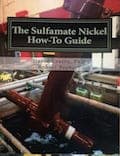
-----
Analytical tool to measure saccharin and butynediol concentrations in Nickel sulfamate electroforming bath
Q. Our topic might not be very interesting but the answer should be easy...
We are a surface treatment company that has just developed its own Nickel electroforming process. We use for the first time organic compounds like saccharine & butynediol.
We don't know how to measure the concentrations of these compounds in our bath. So far we have sub-contracted the measurements but we would like to make them internally since we are industrialising our process for large production. We have seen in the literature that CV Cyclic Voltammetry could be used. There must be well established techniques and analytical equipment since organic compounds are quite widely used in electroplating.
Plating shop technician - Toulouse, France
2007
|
|
The best way is probably to use HPLC; I got saccharin analysis down to about 10 ppb detection limit and 1,4-butyne diol down to about 100 ppb. I cannot recall if I used a conductivity or UV detector, but I used acetyl nitrile as a solvent and the equipment was made by Dionex. The problem is that the concentrations are very low in the electroforming bath, but the nickel levels are very high, so high dilutions need to be used. I know you can use solvent extraction (chloroform) for saccharine, but do not know for butyne diol, so perhaps a technique could be developed around that methodology...  Trevor Crichton R&D practical scientist Chesham, Bucks, UK 2007 The method that I use is based upon proprietary reagents so I won't give it to you. It is, however, based upon information available from the suppliers of sodium saccharine and 1,4 butynediol. I would suggest you get the information from them for relatively simple wet titrations. Gene Packman- Great Neck, New York 2007 |
![]() Thank's Trevor, Gene for your quick responses.
Thank's Trevor, Gene for your quick responses.
Indeed HPLC is the technique used for the analysis of saccharine in the food industry (according to the literature). But most surface treatment companies cannot afford to buy such equipment.
From my knowledge they use manual or automated titration techniques.
I have seen a couple of publications on potentiometric titration for saccharine, but nothing for butynediol.
Cyclic Voltammetry seems to be a good candidate too, but it might require skilled technician to run it.
I will contact the suppliers of the products as suggested by Gene, and will let you know.
Kind regards
Julio
Electroforming - Toulouse, France
A. Depending on how quantitative you want to get, you might have luck with a TLC or paper chromatography technique.
How intense the visualized spot is can give you some semi-quantitative information.
There are likely methods in the AOAC handbook (food analysis) for saccharin that could be adapted to your problem. If you can get that compound with the triple bond extracted from the solution matrix, you might have luck reacting it with a known amount of bromine, then back titrating the excess.

Dave Wichern
Consultant - The Bronx, New York
2007
|
|
Julio, process supplier - Great Neck, New York Thanks Dave, Electroforming - Toulouse, France |
Q. I'm curious if you found a technique to analyze the Butynediol? Particularly any specifics on the titration method...
Thanks for any responses.
- Seattle, Washington, USA
June 30, 2010
Q. Concerning the HPLC method of determining butynediol by Trevor Crichton: The solvent mentioned is acetyl nitrile; is that the same as acetonitrile?
Ulla Petersen- Kvistgaard, Denmark
January 6, 2011
Correct - the solvent is acetonitrile.

Trevor Crichton
R&D practical scientist
Chesham, Bucks, UK
April 23, 2021
A. I just read the responses for wet analysis of sodium saccharin. The most important step is adding sufficient hydrochloric Acid to effectively reduce pH of the nickel bath tested below 2.0. This step chemically changes sodium saccharin to its saccharin acid species. Being no longer water soluble we aggressively mix the solution enabling the acid saccharin to become soluble in the Ethyl Acetate solvent. The final step is typical acid / base titration, achieving the Sodium Saccharin end product.
Stephen Rudy- East Hanover New Jersey
March 27, 2021
Brightener consumption in nickel plating
Q. Hello everyone
I want to say thanks first -- I learn so much on this website from forums and members.
I have a small bath 20 l of bright nickel: nickel sulphate, nickel chloride boric acid and brighteners. Now after time of plating I suppose have brightener consumption and get semi-bright deposit. I don't have access to any lab for detailed analysis of solution etc. -- just basics pH, temp...
So what I am asking for help with is which brightener is consumed more while plating, saccharine or 1,4 butynediol? I don't have much drag out loses because I spray parts with distilled water above tank after plating.
Should I put 1/3 of total when making bath, of saccharine and 1/3 of 1,4 butynediol. Or more? How much? What is more consumed during plating saccharine or butynediol? Also at startup of bath it is added small amount of phthalmide. Any advice is appreciated.
- Split, Croatia
April 23, 2019
April 2019
9th Edition, Vol. 5
"Surface Cleaning, Finishing & Coating"

on eBay or Amazon
or AbeBooks
(affil link)
A. Hi Marin. This is book knowledge, not advice from an experienced nickel plater ...
Saccharin is considered a "carrier" which extends the bright range; it is used in the wide range of 1 to 24 g/l and is not consumed except by dragout (of which you have almost none). 1,4 butynediol is considered both a brightener and an auxiliary brightener, and is used in the very wide range of 0.005 to 4 g/l, and it is consumed by electrolysis. The above is extracted from ASM Metals Handbook vol. 5.
It sounds to me like you should add the 1,4 butynediol but no saccharin, and that your first acquisition should probably be a Hull Cell ⇦ huh? :-)
Regards,

Ted Mooney, P.E. RET
Striving to live Aloha
finishing.com - Pine Beach, New Jersey
Ted is available for instant help
or longer-term assistance.
![]() Thanks very much Ted for that information. I will do what the book says.
Thanks very much Ted for that information. I will do what the book says.
And I really need to buy that book.
Best regards,
- Split, Croatia
April 26, 2019
Q, A, or Comment on THIS thread -or- Start a NEW Thread
